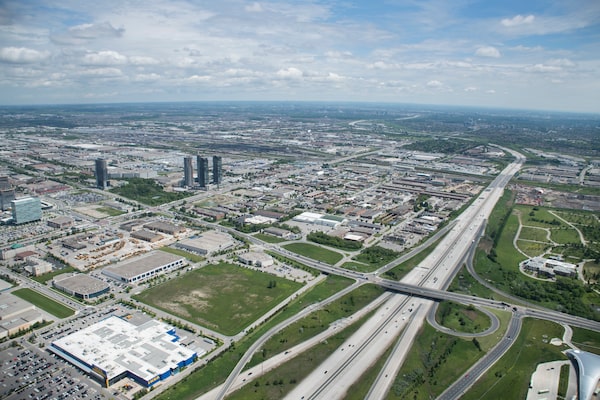
The 407 toll highway (running bottom to top of photo) passes under Jane St., as photographed from a helicopter, in June, 2019.Fred Lum/The Globe and Mail
Conservatives used to believe in the concept of user-pay. And now, they, and their opponents, believe in user-gets-paid.
In 1999, when Ontario’s Progressive Conservative government privatized Highway 407, it followed the logic of user-pay. Using a toll on drivers to pay for a road was straight out of the economic textbook. It allowed Queen’s Park to move the cost of the highway off its books, and off the back of taxpayers, freeing up government revenues – which just like roads are a finite resources – for other purposes.
User-pay highways promised to leave government with more money for higher priorities – health care, education, tax cuts, whatever. It would put the burden of paying for a road on the people using the road. And while making something free promotes overuse, having users pay would encourage the opposite.
That was the wave of the future, way back when in the Mesolithic era. But it turns out that a lot of voters like free roads. And they don’t really mind being kept in the dark about who is paying to make driving “free,” or what governments and taxpayers can’t afford as a result.
Which brings us to the latest political brainwave from the current Progressive Conservative Premier of Ontario, Doug Ford: a promise to expand the busiest stretch of blacktop in North America, Highway 401 through the Greater Toronto Area, by tunnelling a second highway underneath it.
It’s unclear what the price tag would be – betting starts in the tens of billions and runs into the hundreds of billions – or how many years (or decades) it would take, or what distance it would cover, or how many lanes it would have. Not one jot has been studied yet, but no matter. Mr. Ford said last week that it would be built, and of course, without tolls.
This week, he announced that alternatives are also on the table, such as buying back the 407. Or reducing traffic on the 401 by giving truckers a subsidy to drive on the 407.
That last idea that has long been supported by the opposition parties, and it shows just how far we’ve come since 1999: from the economic and fiscal virtues of user-pay to the political alchemy of pay-the-users.
It may be economically and fiscally bonkers, but it turns out to be quite politically popular. Talk of free highways on top of free highways stands a good chance of powering Mr. Ford to re-election.
There are excellent reasons for subsidizing some things, but driving isn’t one of them. Free public schools? We introduced those more than a century ago to encourage education for everyone, regardless of income. Free libraries? Same.
But Ottawa got out of subsidizing air travel back in the 1990s, when the federal government turned major airports and the air traffic control system into user-pay operations. For example, Toronto Pearson International Airport charges departing passengers a $35 airport improvement fee, which last year raised $615-million. That’s how Pearson pays for billions of dollars of past construction, and billions more in future. Users pay, not taxpayers.
How long until some clever politician pitches the idea of “giving Canadians a break on the high cost of vacations” by getting rid of evil airport fees, and quietly handing the bill to taxpayers?
That is pretty much what’s happened across Canada, and across the political spectrum, when it comes to major road infrastructure.
In the early 2010s, when prime minister Stephen Harper’s government started construction of a new Champlain Bridge in Montreal, it planned to pay for it with tolls. Of course. But in the 2015 federal election, Liberal Leader Justin Trudeau promised no tolls. As a result, the $4.2-billion project cost taxpayers $4.2-billion, and drivers $0.
When Metro Vancouver’s Port Mann Bridge opened in 2012, it was the world’s widest long-span bridge. A centre-right Liberal government in B.C. planned to pay for this engineering feat through tolls. But in the 2017 provincial election, the New Democrats promised to remove tolls there and on the Golden Ears Bridge, handing the costs to taxpayers. They’ve been the government ever since.
As for Mr. Ford, he previously made vehicle permits free (cost to the province: $1.1-billion a year), lowered the gas tax (cost: $1.2-billion a year), removed tolls on highways 412 and 418, and banned future toll highways. A promise to build a toll-free highway underneath the continent’s biggest and busiest toll-free highway, at taxpayer expense, is perfectly on-message.
More than any other Canadian politician, Mr. Ford has successfully branded himself as the Premier of the Car. It won him re-election in 2022. Don’t bet against it working again.